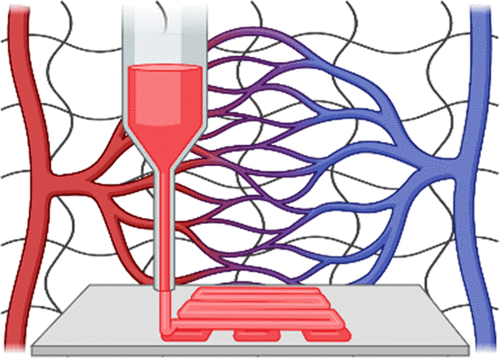当前位置:
X-MOL 学术
›
Chem. Rev.
›
论文详情
Our official English website, www.x-mol.net, welcomes your feedback! (Note: you will need to create a separate account there.)
Biomaterials for Bioprinting Microvasculature.
Chemical Reviews ( IF 62.1 ) Pub Date : 2020-09-01 , DOI: 10.1021/acs.chemrev.0c00027 Ryan W Barrs 1, 2 , Jia Jia 1, 2 , Sophia E Silver 1, 2 , Michael Yost 3 , Ying Mei 1, 2
Chemical Reviews ( IF 62.1 ) Pub Date : 2020-09-01 , DOI: 10.1021/acs.chemrev.0c00027 Ryan W Barrs 1, 2 , Jia Jia 1, 2 , Sophia E Silver 1, 2 , Michael Yost 3 , Ying Mei 1, 2
Affiliation

|
Microvasculature functions at the tissue and cell level, regulating local mass exchange of oxygen and nutrient-rich blood. While there has been considerable success in the biofabrication of large- and small-vessel replacements, functional microvasculature has been particularly challenging to engineer due to its size and complexity. Recently, three-dimensional bioprinting has expanded the possibilities of fabricating sophisticated microvascular systems by enabling precise spatiotemporal placement of cells and biomaterials based on computer-aided design. However, there are still significant challenges facing the development of printable biomaterials that promote robust formation and controlled 3D organization of microvascular networks. This review provides a thorough examination and critical evaluation of contemporary biomaterials and their specific roles in bioprinting microvasculature. We first provide an overview of bioprinting methods and techniques that enable the fabrication of microvessels. We then offer an in-depth critical analysis on the use of hydrogel bioinks for printing microvascularized constructs within the framework of current bioprinting modalities. We end with a review of recent applications of bioprinted microvasculature for disease modeling, drug testing, and tissue engineering, and conclude with an outlook on the challenges facing the evolution of biomaterials design for bioprinting microvasculature with physiological complexity.
中文翻译:

用于生物打印微脉管系统的生物材料。
微脉管系统在组织和细胞水平上发挥作用,调节氧气和营养丰富的血液的局部质量交换。尽管在大型和小型血管替代品的生物制造方面取得了相当大的成功,但功能性微血管由于其尺寸和复杂性而对其工程设计尤其具有挑战性。最近,三维生物打印通过基于计算机辅助设计实现细胞和生物材料的精确时空放置,扩大了制造复杂微血管系统的可能性。然而,可打印生物材料的开发仍面临重大挑战,以促进微血管网络的稳健形成和受控 3D 组织。这篇综述对当代生物材料及其在生物打印微脉管系统中的具体作用进行了彻底的检查和批判性评估。我们首先概述了能够制造微血管的生物打印方法和技术。然后,我们对使用水凝胶生物墨水在当前生物打印模式的框架内打印微血管化结构进行了深入的批判性分析。最后,我们回顾了生物打印微脉管系统在疾病建模、药物测试和组织工程方面的最新应用,并展望了具有生理复杂性的生物打印微脉管系统的生物材料设计的演变所面临的挑战。
更新日期:2020-10-15
中文翻译:

用于生物打印微脉管系统的生物材料。
微脉管系统在组织和细胞水平上发挥作用,调节氧气和营养丰富的血液的局部质量交换。尽管在大型和小型血管替代品的生物制造方面取得了相当大的成功,但功能性微血管由于其尺寸和复杂性而对其工程设计尤其具有挑战性。最近,三维生物打印通过基于计算机辅助设计实现细胞和生物材料的精确时空放置,扩大了制造复杂微血管系统的可能性。然而,可打印生物材料的开发仍面临重大挑战,以促进微血管网络的稳健形成和受控 3D 组织。这篇综述对当代生物材料及其在生物打印微脉管系统中的具体作用进行了彻底的检查和批判性评估。我们首先概述了能够制造微血管的生物打印方法和技术。然后,我们对使用水凝胶生物墨水在当前生物打印模式的框架内打印微血管化结构进行了深入的批判性分析。最后,我们回顾了生物打印微脉管系统在疾病建模、药物测试和组织工程方面的最新应用,并展望了具有生理复杂性的生物打印微脉管系统的生物材料设计的演变所面临的挑战。



























 京公网安备 11010802027423号
京公网安备 11010802027423号